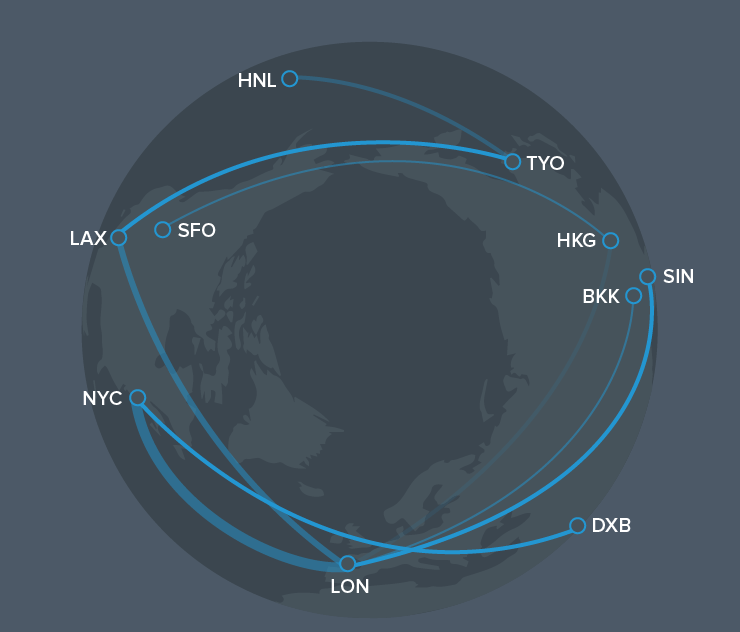 |
| Long-haul routes with Wi-Fi equipped aircraft. Photo: Routehappy |
[Avionics Today 01-15-2016] More airlines than ever before committed to equipping aircraft for In-Flight Connectivity (IFC) in 2015, according to Routehappy’s yearly “Global State of In-Flight Wi-Fi” report, released Jan. 14. As most airlines rolling out equipage in 2015 have reached near or full completion, now, more than ever before, passengers have a chance of stepping onto an aircraft with in-flight Wi-Fi. According to the report, more than one third of Available Seat Miles (ASMs) offer IFC, giving passengers a 36 percent chance worldwide of flying on a connected aircraft.
Here’s the breakdown of 2015 IFC equipage and what to expect in 2016.
The U.S. Still Leads the Charge
The number ASMs with a chance of Wi-Fi buoys significantly in the United States, where 71 percent of aircraft are equipped. Seven percent of aircraft are still in the process of rolling out IFC, and many U.S. airlines are nearing the finish line for planned installations in 2016. This leaves only 22 percent of aircraft in the U.S. un-equipped as opposed to non-U.S. or Rest of World (ROW) airlines, where the numbers flip and nearly 76 percent of aircraft operate without Wi-Fi. According to the report, there are now 53 non-U.S. airlines that offer IFC, including Emirates, Lufthansa and Etihad, “with more coming in 2016.
Delta, United and American Airlines offer the most ASMs with IFC of all carriers worldwide. Delta leads with more than 550 million Wi-Fi-equipped ASMs across its fleet, although its two competitors are quickly closing the gap. American expanded coverage with nearly 350 Wi-Fi-enabled aircrafts from US Airways as the major merger completed in 2015. Meanwhile, United offers the most long haul ASMs, with more than 2,800 miles, and remains (for now) the only U.S. major carrier with the best connectivity, according to Routehappy.
Virgin America stands out as the only U.S. airline with nearly 100 percent of its fleet equipped. Virgin is planning to resolve the few remaining aircraft in its fleet and equip for Wi-Fi on flights to/from Hawaii this year. Scoot — a Singapore-based Low Cost Airline (LCC) — Icelandair, Southwest, Etihad and JetBlue also posted impressive equipage numbers for 2015, boasting IFC across more than 60 percent of their fleets.
 |
| 78 percent of US airlines are equipped or equipping with IFC. Photo: Routehappy |
First Turned Out Not to Be Best
Routehappy found that some airlines that raced to offer in-flight Wi-Fi early on have since gone out of business or grounded those aircraft due to financial issues. This includes Japan’s Skymark, which began offering free Panasonic IFC to passengers on its Airbus A330s in July 2014, and entered bankruptcy in January 2015 over the looming debt of pending A380 deliveries, according to the Center for Aviation. Russia’s Transaero was also a victim and, after equipping nearly 30 aircraft for Wi-Fi, announced Russia’s largest state-run carrier Aeroflot would acquire it in September 2015 after racking up nearly $990 million in debt.
 |
| The rate of rollout for airlines who have chosen to equip. Photo: Routehappy |
Good Enough Isn’t Good Enough Anymore
High-speed, in-flight broadband access is coming, and passengers are clamoring for it.
“In addition to Wi-Fi being more widely available, the core technology behind in-flight Wi-Fi has also evolved to allow for faster and more reliable connections. The mere availability of Wi-Fi is no longer enough. Passengers now demand a home broadband-like experience, and more airlines are now delivering this,” Routehappy noted in a statement alongside the release of the report.
Last year, the best Wi-Fi connectivity was available on less than 1 percent of U.S. flights, and while that number has since grown to 6 percent of in-flight Wi-Fi offered worldwide, airlines are still searching out ways to improve reliability and speed.
To this end, JetBlue is nearing completion of a fleet-wide broadband rollout, allowing free access to Netflix and other streaming services. Similarly, Virgin America also struck a deal with ViaSat earlier this year to equip 10 of its A320 aircraft with Wi-Fi that is currently providing streaming Netflix to passengers. Additionally, airlines such as Delta, Aeromexico, Virgin Atlantic, Lufthansa, and others are preparing to launch high-speed broadband solutions in the near future.
 |
| A breakdown of how the level of connectivity systems airlines are equipped with. Photo: Routehappy |